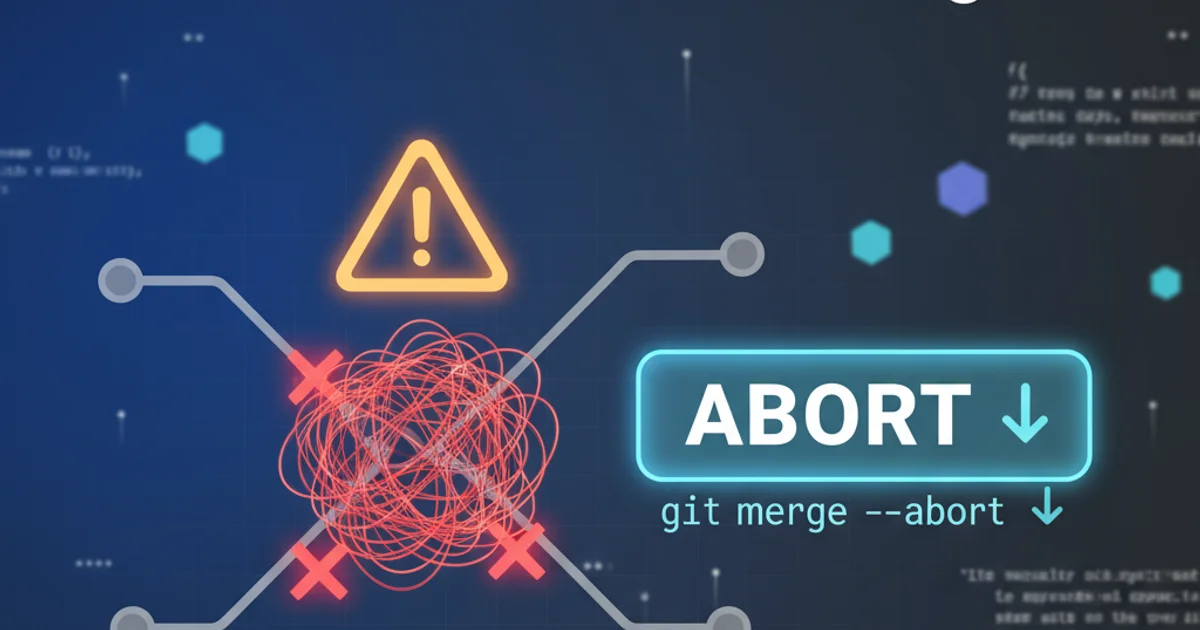I ran into a merge conflict. How do I abort the merge?
Categories:
How to Abort a Git Merge Conflict

Learn how to safely abort a Git merge operation when you encounter conflicts, restoring your repository to its state before the merge attempt.
Encountering a merge conflict in Git can be daunting, especially if you're new to version control. A merge conflict occurs when Git cannot automatically reconcile differences between two branches being merged. Instead of forcing a potentially incorrect merge, Git pauses the process, allowing you to resolve the conflicts manually. However, sometimes the best course of action isn't to resolve the conflict, but to abort the merge entirely and return to a clean state. This article will guide you through the process of safely aborting a Git merge.
Understanding Merge Conflicts
Before we dive into aborting a merge, it's helpful to understand what a merge conflict signifies. When you run git merge <branch-name>, Git attempts to integrate changes from <branch-name> into your current branch. If the same lines of code have been modified differently in both branches, or if a file was deleted in one branch and modified in another, Git cannot decide which version to keep. It marks these areas as conflicts and leaves the resolution to you.
flowchart TD
A[Start Merge] --> B{Conflicts Detected?}
B -- No --> C[Merge Successful]
B -- Yes --> D[Merge Paused (Conflict State)]
D --> E{Resolve Conflicts?}
E -- Yes --> F[Commit Merge]
E -- No --> G[Abort Merge]
G --> H[Return to Pre-Merge State]
F --> CFlowchart illustrating the Git merge process and conflict resolution options.
Identifying a Merge Conflict State
When a merge conflict occurs, your terminal will typically display messages indicating the conflict. Git also modifies the conflicting files, adding special markers (like <<<<<<<, =======, >>>>>>>) to highlight the conflicting sections. Your Git status will also reflect the ongoing merge.
git status
Check your Git status to confirm a merge conflict.
The output of git status during a conflict will look something like this:
On branch main
You have unmerged paths.
(fix conflicts and run "git commit")
(use "git merge --abort" to abort the merge)
Unmerged paths:
(use "git add <file>..." to mark resolution)
both modified: src/App.js
both modified: styles/main.css
no changes added to commit (use "git add" and/or "git commit -a")
Example git status output during a merge conflict.
git status when you suspect a conflict or are unsure of your repository's state. It provides crucial information and often suggests the next steps, including how to abort.Aborting the Merge
If you decide that resolving the conflicts is too complex, or if you simply want to rethink your merge strategy, you can abort the merge. Aborting a merge will revert your repository to the exact state it was in before you initiated the merge command. All changes from the merge attempt will be discarded, and your working directory will be clean.
1. Step 1: Open your terminal or Git Bash.
Navigate to your repository's root directory.
2. Step 2: Execute the abort command.
Type the following command and press Enter:
3. Step 3: Verify the abort.
Run git status again. You should see that you are back on your original branch, and there are no unmerged paths or merge in progress messages.
git merge --abort
The command to abort an ongoing merge.
After running git merge --abort, Git will undo all changes related to the merge attempt. This includes reverting any files that were modified by the merge process (even those without conflicts) and removing the conflict markers from files that had conflicts. Your branch will be exactly as it was before you ran git merge.
git merge --abort command only works if the merge was initiated with git merge and has not yet been committed. If you've already committed some merge resolutions, or if you used git pull (which is often git fetch followed by git merge), you might need to use git reset --hard HEAD or git reset --merge (for git pull conflicts) to revert, but be cautious as git reset --hard discards all local changes.When to Abort vs. Resolve
Deciding whether to abort a merge or resolve the conflicts depends on the situation:
- Abort if: The conflicts are extensive and complex, you're unsure how to resolve them correctly, or you realize you initiated the merge prematurely or from the wrong branch. It's also useful if you want to pull the latest changes from the remote before attempting the merge again.
- Resolve if: The conflicts are minor, you understand the changes in both branches, and you're confident in manually integrating them. Resolving conflicts is a fundamental Git skill and often the most direct path forward.
Aborting a merge is a safe and effective way to back out of a problematic merge attempt. It allows you to reset your repository to a clean state, giving you the opportunity to re-evaluate your approach, pull new changes, or simply try the merge again later with a clearer strategy.